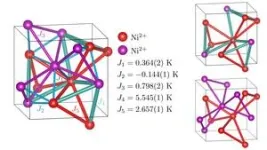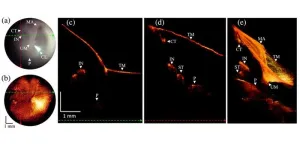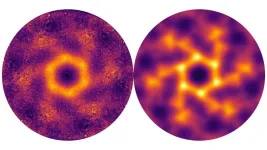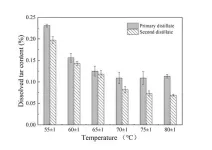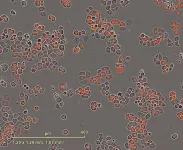(Press-News.org) Jacqueline Sperling, PhD, a clinical psychologist and assistant professor of Psychology at Harvard Medical School, and co-program director of the McLean Anxiety Mastery Program, led a study investigating the sustainability of outcomes from an intensive group and family-based outpatient cognitive behavioral treatment (CBT) program, that included a hybrid of in-person and virtual treatment sessions for children and adolescents with anxiety disorders and/or obsessive-compulsive disorder (OCD). Her research, which was published last month in Current Developmental Disorders Reports, suggests that an intensive hybrid format may offer lasting gains even after children have finished treatment.
In addition to Sperling, other McLean authors include Abigail Stark, PhD, Esther Tung, PhD and R. Meredith Elkins, PhD. Sperling describes her team’s research and how the COVID-19 pandemic spurred this investigation into virtual components of child and adolescent mental health treatment.
What led you to explore this area of research?
Our previous research has demonstrated that intensive group and family-based outpatient CBT can yield improvements in symptoms and functional impairment for children with anxiety and OCD using either in-person or virtual formats, with no significant differences between the two. For this new study, we wanted to see whether a hybrid format of both in-person and virtual treatment sessions not only could demonstrate similar outcomes, but also could offer lasting gains months after discharge from the treatment program.
This topic especially was of interest to our group given how treatment delivery models have shifted since the COVID-19 pandemic, to include more virtual sessions.
How did you conduct the study?
Our study participants included 63 children and adolescents between ages 8 and 19, who were treated at McLean’s Anxiety Mastery Program (MAMP).
Patients at MAMP received intensive outpatient group- and family-based CBT from a care team that included a psychologist, psychiatrist and doctoral student. Prior to the COVID-19 pandemic, the program consisted of individually tailored in-person treatment for four afternoons a week, from a minimum of four weeks to an average of eight weeks. Three of the afternoons offered group-based treatment, which included treatment-review check-ins with caregivers afterward, and on one of the days, each family participated in two, weekly 45-minute sessions with a psychologist and psychiatrist. In addition to daily check-ins and participation in weekly family and psychopharmacology meetings, and caregivers attended caregiver guidance groups, one to two times per week, a frequency that changed in response to caregivers’ feedback and attendance.
Caregivers and their children completed questionnaires at the start of treatment, the last day of treatment, and three months after treatment ended. When examining caregivers’ and children’s responses, the changes in the program’s format were accounted for in analyses.
In March 2020 when the COVID-19 pandemic unfolded, we shifted to an entirely virtual model offering telehealth-based intensive treatment. By the summer of 2022, we transitioned to a hybrid model of care, with one in-person group-based day and three virtual treatment days each week.
Caregivers and their children completed questionnaires at the start of treatment, the last day of treatment, and three months after treatment ended. The analyses focused on the families’ responses at each of those timepoints.
What did your findings reveal?
Both caregivers and youth in the hybrid program not only reported significant improvements in children's anxiety and depression symptoms as well as functional impairment by discharge, but they also reported that the treatment gains had persisted three months after discharge.
Our results suggest that intensive outpatient group- and family-based CBT that integrates telehealth can lead to lasting improvements in pediatric anxiety and OCD symptoms beyond discharge. It is important to note that the treatment program recommended that families pursue less intensive outpatient CBT after discharge to facilitate the sustainment of treatment gains, and the majority of families reported that they did have their children continue to meet with outpatient clinicians after discharge. Therefore, this study cannot determine which factors, the intensive program and/or the subsequent outpatient treatment, contributed to the sustainment of treatment gains. It may be that both are needed so children can build upon the foundation of progress established in an intensive short-term program.
What are the implications of this work for patients and their families and physicians?
Some research has found that one-third of children or more will have an anxiety disorder before adulthood. If untreated, there can be lifelong negative impacts, such as: challenges with interpersonal relationships, increased risk for mental health and other health complications, and struggles with finances and careers. OCD has been found to affect 2-3 percent of youth and also can contribute to persisting impairment into adulthood if not treated effectively. For those reasons, treatments that provide lasting effects for children are needed significantly.
Given the well-documented increase in rates of child and adolescent mental illnesses during the COVID-19 pandemic, an intensive, hybrid treatment format may be a way to increase access to much-needed care.
END
Research spotlight: evaluating hybrid and virtual treatments for children with anxiety and obsessive-compulsive disorder
2024-08-23
ELSE PRESS RELEASES FROM THIS DATE:
Battelle names Anibal Boscoboinik 'Inventor of the Year'
2024-08-23
Anibal Boscoboinik, a materials scientist at the U.S. Department of Energy’s (DOE) Brookhaven National Laboratory, has been named an “Inventor of the Year” by Battelle Memorial Institute. Battelle, headquartered in Columbus, Ohio, partners with Stony Brook University to form Brookhaven Science Associates, which manages the Lab on behalf of DOE’s Office of Science. Battelle manages or co-manages nine national labs across the country.
At Battelle’s yearly Celebration of Solvers, they award Inventor of the ...
Toward a code-breaking quantum computer
2024-08-23
CAMBRIDGE, MA — The most recent email you sent was likely encrypted using a tried-and-true method that relies on the idea that even the fastest computer would be unable to efficiently break a gigantic number into factors.
Quantum computers, on the other hand, promise to rapidly crack complex cryptographic systems that a classical computer might never be able to unravel. This promise is based on a quantum factoring algorithm proposed in 1994 by Peter Shor, who is now a professor at MIT.
But while researchers have taken great strides in the last 30 years, scientists ...
New imaging device improves ear disease diagnosis
2024-08-23
In the realm of ear health, accurate diagnosis is crucial for effective treatment, especially when dealing with conditions that can lead to hearing loss. Traditionally, otolaryngologists have relied on the otoscope, a device that provides a limited view of the eardrum’s surface. This conventional tool, while useful, has its limitations, particularly when the tympanic membrane (TM) is opaque due to disease.
Enter a groundbreaking advancement from the University of Southern California's Caruso Department of Otolaryngology: a portable OCT otoscope that integrates optical coherence tomography (OCT) with ...
Langbeinites show talents as 3D quantum spin liquids
2024-08-23
A 3D quantum spin liquid has been discovered in the vicinity of a member of the langbeinite family. The material's specific crystalline structure and the resulting magnetic interactions induce an unusual behaviour that can be traced back to an island of liquidity. An international team has made this discovery with experiments at the ISIS neutron source and theoretical modelling on a nickel-langbeinite sample.
When spins in a crystal lattice cannot align to reach a minimum energy together, this is called magnetic frustration. ...
VA funds IU School of Medicine research projects relevant to veterans’ health
2024-08-23
INDIANAPOLIS – Indiana University School of Medicine researchers have cumulatively been awarded nearly $4 million in grant funding through the U.S. Department of Veterans Affairs' Merit Review Award and Career Development programs to support research on diabetes, skin inflammation, cancer and aging.
The Merit Review Award Program supports investigator-initiated research conducted by eligible VA investigators at either VA medical centers or approved sites. This program serves as the VA's primary method for funding basic, preclinical, ...
Researchers identify effective materials for protecting astronauts from harmful cosmic radiation on Mars
2024-08-23
Abu Dhabi, August 23, 2024: Researchers have identified specific materials, including certain plastics, rubber, and synthetic fibers, as well as Martian soil (regolith), which would effectively protect astronauts by blocking harmful space radiation on Mars. These findings could inform the design of protective habitats and spacesuits, making long-duration Mars missions more feasible. Because Mars lacks Earth’s thick atmosphere and magnetic field, astronauts exploring the planet would be exposed to dangerous levels of radiation.
Dimitra Atri, Investigator, ...
People seen as wise share these characteristics, according to a new study
2024-08-23
What makes someone seem wise? People view wisdom through the lens of applying knowledge and thinking logically as well as considering others’ feelings and perceptions, finds a new study led by University of Waterloo researchers who looked at perceptions of wisdom across 12 countries and five continents.
Researchers examined the underlying principles guiding who we perceive as wise in political leadership, science, and daily life. Across different cultures, participants’ judgements converged on two dimensions: reflective orientation and ...
Activated bamboo charcoal’s slow-release properties for enhanced anti-acne formulations containing bamboo vinegar
2024-08-23
Bamboo vinegar is a concentrated liquid obtained from bamboo under high temperature and anaerobic conditions. It contains more than 200 organic components, including organic acids, phenols, ketones, alcohols, and esters, among which acetic acid is the main component. Although bamboo vinegar has been approved by the China Food and Drug Administration as a cosmetic raw material, commercially available bamboo vinegar often contains impurities whose efficacy is not clear, and phenolic compounds and aromatic hydrocarbons ...
When is the best time of day for cancer treatment?
2024-08-23
How effective medications are depends on various factors, including the time of day when they are administered. Why? Because our bodies don’t always function exactly the same. Instead, they follow the cycle set by their internal clock, otherwise known as circadian rhythm. But since each person’s circadian rhythm is different and depends on a number of different factors, it is difficult to tailor medication schedules to an individual patient’s body clock. Researchers at Charité – Universitätsmedizin Berlin have now developed a method for determining the optimum time of cancer treatment based on certain breast cancer ...
Rates of obesity-related cancer are rising sharply in young Chinese people
2024-08-23
Obesity-related cancer rates in China were rising at an alarming 3.6% every year between 2007 and 2021 while non-obesity-related cancers remained stable, according to the first comprehensive study published August 22 in the Cell Press journal Med. The increase is particularly pronounced among young people, highlighting the urgent need for better public health policies to address China’s growing overweight and obesity rates.
“If we don’t drastically change the obesity epidemic, the rates of cancer associated with obesity will inevitably continue to rise,” says Jin-Kui Yang, the paper’s corresponding author and an endocrinologist ...

